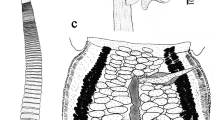Abstract
Two new species of Scyphophyllidium Woodland, 1927 are described from the Hooktooth shark, Chaenogaleus macrostoma (Bleeker), from the Persian Gulf, Iran. Scyphophyllidium hormuziense n. sp. is assigned to morphological category 2 of its genus because it possesses bothridial marginal loculi and an apical sucker on each flat bothridium, and lacks bothridial facial loculi. Within category 2, it is distinguished from its congeners, except for S. janineae (Ruhnke, Healy and Shapero, 2006), by possessing, rather than lacking, a prominent cephalic peduncle. It differs from S. janineae in the distribution of the vitelline follicles. Scyphophyllidium iraniense n. sp. is assigned to morphological category 5 because its bothridia are essentially flat and lack proximal apertures, marginal loculi, facial loci and semi-circular muscle bands, and bears weakly serrate gladiate spinitriches on its distal bothridial surfaces. Within its morphological category, the presence of a long cephalic peduncle distinguishes S. iraniense n. sp. from its congeners lacking this structure or possessing a short cephalic peduncle. It further differs from S. arnoldi (Ruhnke and Thompson, 2006) and S. typicum (Subhapradha, 1955) in total length, from S. paulum (Linton, 1897) in lacking a conspicuous band of muscles along the locular periphery of the bothridia, and from S. kirstenae (Ruhnke, Healy and Shapero, 2006) in the distribution of the vitelline follicles. This study brings the number of the valid Scyphophyllidium species of the Persian Gulf to five.




Similar content being viewed by others
Data availability
All data generated or analyzed during this study are included in this published article. For the raw data, please contact the corresponding author.
References
Caira, J. N., Jensen, K., & Barbeau, E. (2022). Global Cestode Database. World Wide Web electronic publication. www.tapewormdb.uconn.edu. Accessed November 18, 2023.
Caira, J. N., Jensen, K., Hayes, C., & Ruhnke, T. R. (2020). Insights from new cestodes of the crocodile shark, Pseudocarcharias kamoharai (Lamniformes: Pseudocarchariidae), prompt expansion of Scyphophyllidium and formal synonymization of seven phyllobothriidean genera–at last!. Journal of Helminthology, 94, e132. https://doi.org/10.1017/S0022149X20000036.
Caira, J. N., Malek, M., & Ruhnke, T. (2011). A new genus of Phyllobothriidae (Cestoda: Tetraphyllidea) in carcharhiniform sharks from Iran and Australia. Journal of Helminthology, 85(1), 40–50. https://doi.org/10.1017/S0022149X10000222.
Chervy, L. (2009). Unified terminology for cestode microtriches: a proposal from the participants of the International Workshops on Cestode Systematics in 2002–2008. Folia Parasitologica, 56, 199–230. https://doi.org/10.14411/fp.2009.025.
Jabado, R. W., & Ebert, D. A. (2015). Sharks of the Arabian seas: an identification guide, The International Fund for Animal Welfare, Dubai, UAE.
Malek, M., Caira, J. N., & Haseli, M. (2010). Two new species of Paraorygmatobothrium Ruhnke, 1994 (Cestoda: Tetraphyllidea) from the carcharhinid shark Carcharhinus cf. dussumieri (Müller & Henle) in the Persian Gulf. Systematic Parasitology, 76, 59–68. https://doi.org/10.1007/s11230-010-9241-3.
Reyda, F. B. (2008). Intestinal helminths of freshwater stingrays in southeastern Peru, and a new genus and two new species of cestode. Journal of Parasitology, 94(3), 684–699. https://doi.org/10.1645/GE-1230.1.
Ruhnke, T. R. (2011). A monograph on the Phyllobothriidae (Platyhelminthes, Cestoda), Bulletin of the University of Nebraska State Museum 25, 1–208.
Ruhnke, T. R., Caira, J. N., & Carpenter, S. D. (2006). Orectolobicestus n. g. (Cestoda: Tetraphyllidea), with the description of five new species and the transfer of Phyllobothrium chiloscyllii to the new genus. Systematic Parasitology, 65, 215–233. https://doi.org/10.1007/s11230-006-9050-x.
Ruhnke, T. R., Daniel, V., & Jensen, K. (2020). Four new species of Paraorygmatobothrium (Eucestoda: Phyllobothriidea) from sharks of the Gulf of Mexico and the Atlantic Ocean, with comments on their host specificity. Journal of Parasitology, 106(1), 133–156. https://doi.org/10.1645/19-129.
Acknowledgements
We thank the Iranian Fisheries Science Research Institute for allowing us to examine the sharks sampled under their stock assessment project. All necessary permits for sampling and observational field studies had been defined in that stock assessment project.
Funding
This work was carried out under the grant number 5552 assigned to the first author by the University of Guilan.
Author information
Authors and Affiliations
Contributions
MH conceived, designed, and supervised the research. HKP measured and drew. MH wrote the manuscript. All authors read and approved the manuscript. This article is based on the student (HKP)’s MSc thesis.
Corresponding author
Ethics declarations
Competing interests
The authors declare no competing interests.
Ethics approval
All applicable international, national, and/or institutional guidelines for animal testing, animal care, and use of animals were followed by the authors.
Sampling and field studies
All necessary permits for sampling and observational field studies have been obtained by the authors from the competent authorities, the Iranian Fisheries Science Research Institute, and are mentioned in the acknowledgements. The study is compliant with CBD (Convention on Biological Diversity) and Nagoya protocols.
Conflict of interest
The authors declare no competing interests.
Consent to participate
All authors consent to participate in this publication.
Consent for publication
All authors consent to publish the manuscript.
Additional information
Publisher's Note
Springer Nature remains neutral with regard to jurisdictional claims in published maps and institutional affiliations.
Rights and permissions
Springer Nature or its licensor (e.g. a society or other partner) holds exclusive rights to this article under a publishing agreement with the author(s) or other rightsholder(s); author self-archiving of the accepted manuscript version of this article is solely governed by the terms of such publishing agreement and applicable law.
About this article
Cite this article
Kouchaki Panchah, H., Haseli, M. Two new species of Scyphophyllidium (Cestoda: Phyllobothriidea) from Chaenogaleus macrostoma (Bleeker) (Elasmobranchii: Carcharhiniformes) from the Persian Gulf, Iran. Syst Parasitol 101, 18 (2024). https://doi.org/10.1007/s11230-023-10141-0
Received:
Accepted:
Published:
DOI: https://doi.org/10.1007/s11230-023-10141-0




